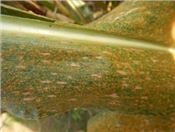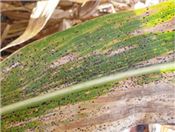Corn Diseases To Watch For In 2016: Southern Rust And Tar Spot
CARL A. BRADLEY
PRINCETON, KY.
Two corn diseases are already making some news this season. Southern rust and tar spot have been detected in southern states and could potentially make their way to Kentucky this season. So, keeping a lookout for these two diseases is a good idea.
Southern Rust
Southern rust (caused by Puccinia polysora) (Figure 1) made an appearance in Kentucky last summer, and turned many combines orange during harvest because of the large number of orange-colored pustules present on the leaves.
Although the fungus that causes southern rust is not able to overwinter in Kentucky, it has already been found in corn fields in Texas, Louisiana, and Georgia this year. This pathogen will move north during the season, but timing is everything. If the disease is found in Kentucky corn fields prior to the milk stage (R3 growth stage), then yield losses may occur. Wet spring weather did delay corn planting in some areas this year, so the table could be set for this disease to be a problem, especially in late-planted corn. Tracking the whereabouts of southern rust in the U.S. will help determine when it may move into Kentucky, and this will continue to be a topic addressed in Kentucky Pest News this season. Many fungicides are able to effectively protect against infection by the southern rust pathogen. Extension plant pathologists from corn-growing states have put together a fungicide efficacy table for corn (Fungicide Efficacy for Control of Corn Diseases, BP-160-W), which is published by Purdue University.
Tar Spot
Tar spot (caused by Phyllachora maydis) (Figure 2) was found in the U.S. for the first time late in the 2015 growing season in the northern portions of the neighboring states, Illinois and Indiana. Although this disease appeared too late in the growing season to cause yield losses, it was observed across several counties in both of those states.
On June 10, 2016, tar spot was detected on corn growing in Palm County, Florida. Although little is known about the ability of this disease to cause losses to corn grown in the U.S., it is important to be on the lookout for the disease. Since this disease has never been reported in Kentucky, it is critically important to work with your local county Extension agent to submit any suspect samples to the University of Kentucky Plant Disease Diagnostic Lab. More information about tar spot of corn can be found in the Purdue University publication, Tar Spot (BP-90-W) . ∆
DR. CARL A. BRADLEY: Extension Plant Pathologist, University of Kentucky

Figure 2. A corn leaf affected by tar spot (note the black,
raised fungal structures – known as ascomata).
Photo: Kiersten Wise, Purdue University

Figure 1. Orange pustules of the southern rust pathogen
covering a corn leaf.
Photo: Carl Bradley, UK